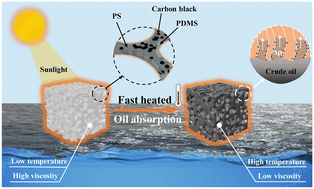Efficient removal of viscous crude oil by a super-hydrophobic polystyrene/carbon black foam with photo-thermal conversion†
Abstract
The efficient treatment of oil spills still remains a worldwide challenge. Traditional hydrophobic absorbents show limitation in absorbing high-viscosity crude oil. Fortunately, increasing the temperature of crude oil is an effective way to enhance its fluidity. Photo-thermal sorbents can convert solar-energy into heat-energy, which can be utilized to increase the crude oil's temperature. We prepared a solar-thermal polystyrene foam (CG-PDMS@PS) from a high internal phase emulsion (HIPE) method. Carbon black and graphene are embedded in the foam to facilitate rapid photo-thermal conversion and the temperature of the foam can reach 79.9 °C under 1.0 kW m−2. Additionally, the introduction of PDMS and graphene enhanced the mechanical properties of the foam. The CG-PDMS@PS foam exhibits super-hydrophobic characteristic even in strong acids and alkaline solutions. For the high-viscosity crude oil, the CG-PDMS@PS foam can reduce its viscosity and achieve rapid adsorption with the assistance of sunlight. We systematically investigated the effects of sunlight intensity and oil-viscosity on the adsorption of crude oil and analyzed the vertical heat transfer capacity and the sinking rate of the foam. Furthermore, the CG-PDMS@PS foam can also be applied in the continuous recovery of oil spills. In view of its unique properties, the CG-PDMS@PS foam provides a new solution to address oil spills.

- This article is part of the themed collection: Nanomaterial applications in water


 Please wait while we load your content...
Please wait while we load your content...